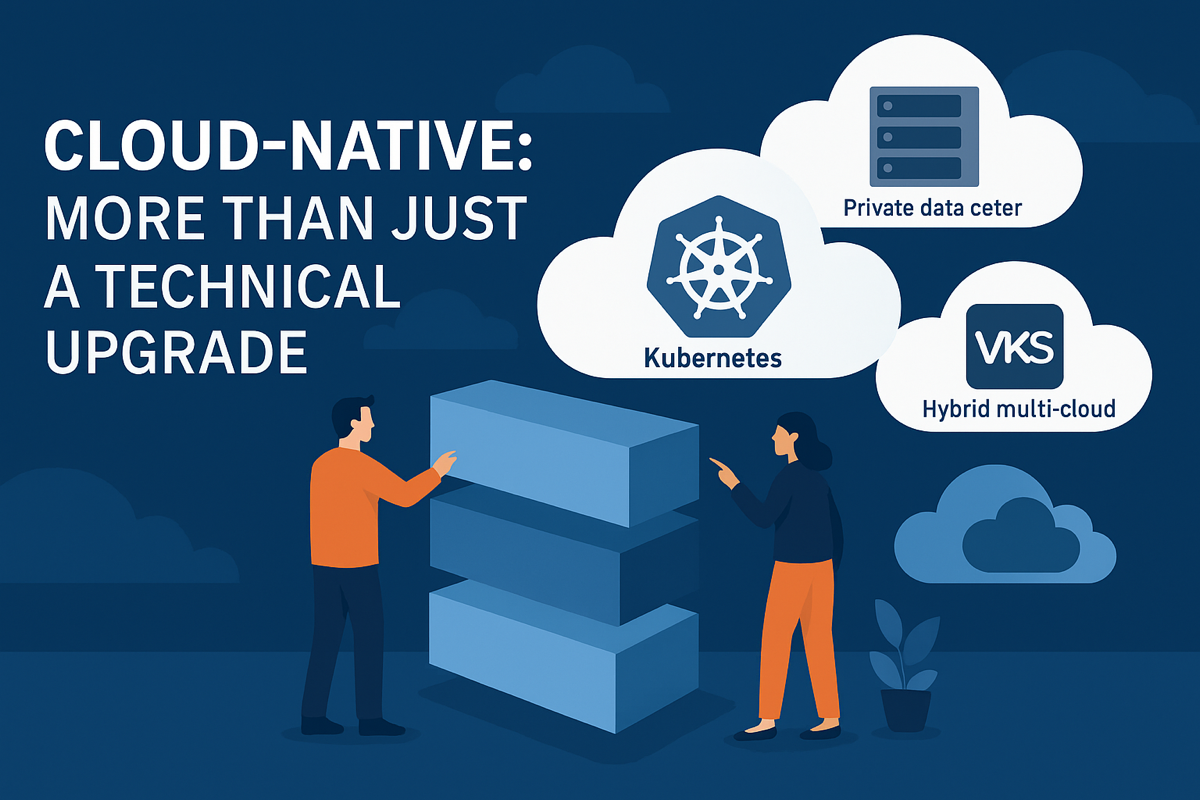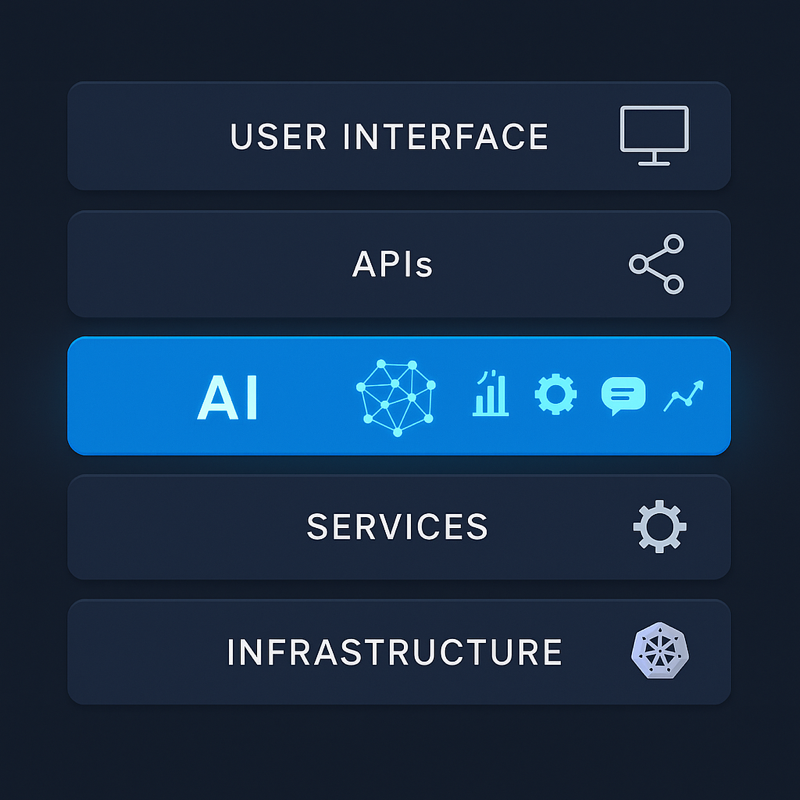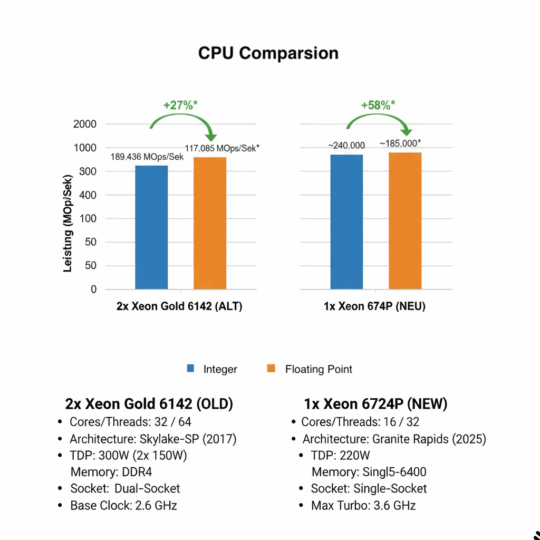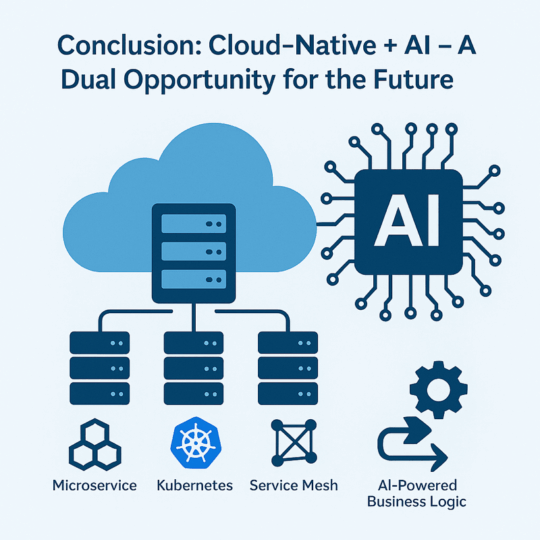VMware, Microsoft, Hyperscalers – Rising Costs as a Strategic Opportunity for Sustainable Efficiency Gains through Cloud-Native Transformation

Recent price increases by VMware (now Broadcom) and major hyperscalers such as Amazon Web Services (AWS), Microsoft Azure, and Google Cloud (GCP) have prompted many organizations to reassess their IT strategies. While this may initially appear to be a burden, it presents a strategic opportunity, especially for companies seeking to modernize their software architecture, data centers, and operational models for sustainable efficiency gains, and to integrate artificial intelligence (AI) meaningfully into their business processes.
Many organizations now face a critical inflection point: Existing systems are becoming increasingly expensive, while demand for innovation, including AI, is rising. Businesses are increasingly searching for ways to embed AI capabilities as integral components of future solutions rather than retrofitting them into outdated architectures. This shift opens the door to digital transformation, not just incremental change. It is a chance, not a burden.
From Uncertainty to Innovation: Why Now Is the Time to Act
The Broadcom acquisition of VMware has introduced substantial changes to the licensing model and strategy. Traditional per-socket licenses have been discontinued in favor of mandatory enterprise subscriptions and bundled feature packages (VCF, VVF), which offer less flexibility. Smaller VMware customers (“Essentials”) are especially affected by the resulting cost increases. In parallel, Microsoft and the hyperscalers are also pushing higher prices and more substantial commitments to subscription-based and cloud-only models, limiting strategic options for many organizations.

As a result, companies must now choose between passively absorbing these rising costs or actively rethinking their IT foundation, breaking out of the vendor lock-in.
Cloud-Native: More Than Just a Technical Upgrade
The “lift and shift” approach has been debated for years and rarely delivered meaningful benefits. Moving workloads to the cloud without modernizing the architecture misses the real potential to increase efficiency.
At CID, we build modular, cloud-native software and datacenter architectures tailored to each customer’s business model – whether in private data centers leveraging on-premises platforms such as VMware VCF/VVF and Kubernetes distributions (e.g., vanilla, bare metal with Kubermatic, VMware VCF with VMware Kubernetes Service) or on hybrid and multi-cloud environments. This is not about short-term migrations, but long-term transformation.

Cloud-Native: More Than Just a Technical Upgrade

One of the most overlooked facts in many environments is that the average utilization rate of existing server infrastructure is only around 10-20%*. Most available computing power remains idle despite high energy consumption, complex maintenance, and expensive licensing structures.
This alone illustrates the massive potential for optimization. Organizations can reduce cost and complexity through right-sizing, modern architecture design, and workload-aware provisioning while unlocking performance and scalability.
* Sources and Publications:
According to a DatacenterDynamics article, a study by Cast AI (based on ~4,000 Kubernetes clusters on AWS, GCP, and Azure in 2023) found that the provisioned CPU utilization rate averages at only ~13%.
(https://www.datacenterdynamics.com/en/news/only-13-of-provisioned-cpus-and-20-of-memory-utilized-in-cloud-computing-report/)
BNL (Lawrence Berkeley National Laboratory) – Data Center Energy Usage Report (2024)
The report projects that “average server operational time” (utilization) for conventional servers in small/internal data centers will reach 20% by 2027 (from 11% in 2014).
(https://revistacloud.com/wp-content/uploads/2024/12/lbnl-2024-united-states-data-center-energy-usage-report.pdf)
AI as a Core Element of Modern Architecture
This moment also brings a unique opportunity: As businesses modernize, they can embed AI capabilities directly into new platforms, rather than patching them onto legacy systems.

At CID, we believe that AI should not be treated as a bolt-on solution but as a native part of the digital architecture, a strategic approach impacting the whole organization whether for intelligent analytics, decision automation, natural language interfaces, or predictive process control.
This strategic integration transforms AI from a mere support tool into a true accelerated game-changer of innovation, efficiency, and competitiveness.
In addition, IT strategies are often based on outdated habits and technologies—monoliths, rigid hypervisors, and static licensing. Meanwhile, the business demands agility, scalability, and value creation. It must accelerate workflows, inspire customers, and enable innovation. The technological foundations for this already exist, and making the shift is often more economical than maintaining outdated systems, at least mid- to longer-term.
The technological foundations for innovation already exist—VMware’s new VCF (VMware Cloud Foundation) subscription model is a prime example: Traditionally, IT environments were hampered by static licensing models and fragmented toolsets. Features like advanced monitoring (formerly vRealize Operations), infrastructure automation (formerly vRealize Automation), and integrated Kubernetes support (now VMware Tanzu Kubernetes Grid or VMware Kubernetes Service) were available, but often underutilized or not even recognized as a valuable solution. These tools were sometimes included in Enterprise License Agreements (ELA), but their adoption lagged due to complexity, lack of awareness, insufficient skills, or disjointed deployment models.
This is where the new VCF approach changes the game. With VCF’s subscription model, these formerly standalone products are now bundled into one integrated solution, automatically deployed and configured as part of the platform. Customers no longer need to license, install, and manage each component individually. Instead, they get an out-of-the-box foundation with consistent operations visibility and automated resource provisioning across virtual machines and Kubernetes workloads.
This shift levels the playing field with hyperscalers, who have long benefited from tightly integrated management and automation stacks. VMware now delivers comparable experience on-premises: Scalable, agile, and optimized for modern workloads. By leveraging these built-in tools, which are no longer optional or hidden behind additional licensing, organizations can finally realize the full potential of their infrastructure investments. The once hidden tools are now accessible, integrated, and enabled by default. That is the fundamental transformation while the new bundles reduce à-la-carte flexibility, they increase integrated value and operational consistency—and can be more economical when you standardize on the stack.

Modernization Is a Mindset – Not Just New Hardware
When modernizing infrastructure, right-sizing is often overlooked.
Modern CPUs offer significantly higher performance per core. Replacing hardware 1:1 can result in substantial over-provisioning unless you count for the performance gains. A workload that previously required 60% CPU usage on a 2017 system might only need 30% on a modern equivalent, directly changing how many cores (and licenses) are required.
How does it look like we reduce the CPU Cores in a new available up to date CPU?

We reduce the half of the cores and have similar, even a bit more performance, as you can see on the diagram above, with the benefit of half of the licensing costs for a lot of software running on top of the servers. If you reinvest these savings into modernizing your software stack including AI Acceleration for your business, your efficiency gains and earnings are even more important.
Of course, modernizing infrastructure must also include rethinking backup and disaster recovery strategies about performance and compliance. In today’s landscape, the primary threat is no longer natural disasters like fires or floods, but increasingly sophisticated cyberattacks—ransomware, data corruption, and targeted breaches. Traditional architectures often relied heavily on synchronous replication, a popular method in regions like DACH. While it protects against physical infrastructure failures, it offers little defense against logical threats that can instantly propagate across mirrored environments.
Modern strategies must shift toward immutable snapshots, which preserve point-in-time data states that malicious actors cannot alter or delete. When combined with secure air-gapped or logically isolated backup environments, these snapshots provide a resilient foundation against cyber threats. This approach enhances recovery capabilities and aligns better with regulatory compliance requirements.
The paradigm has changed: Resilience is no longer just about geographic redundancy—it’s about logical integrity, rapid recovery from unplanned events, and the ability to detect and respond to security incidents. Rethinking DR (Disaster Recovery) with this in mind is no longer optional—it is essential.
Conclusion: Cloud-Native + AI – A Dual Opportunity for the Future
Yes, licensing models have changed. Yes, costs are rising. But instead of reacting with short-term fixes, now is the time to fundamentally rethink your IT architecture.

Moving toward cloud-native solutions, micro-services, Kubernetes platforms, service meshes, CI/CD pipelines, and AI-powered business logic offers a rare opportunity to reduce cost and build a future-proof foundation for innovation and growth.
It ensures your infrastructure finally works smarter, not harder.
At CID, we are ready to support your change with deep technical expertise, industry knowledge, and a clear understanding of your long-term business goals.
What Sets CID Apart: Client-Centered Consulting, Not Sales Targets
At CID, we embrace a holistic view. Rather than chasing short-lived vendor trends or meeting arbitrary sales quotas, we focus on what truly matters: Crafting bespoke strategies that align with your unique business model, challenges, and long-term vision. Whether your goals require incremental improvements or a complex, multi-phase transformation, we tailor our proven best practices to meet your needs.
Our most impactful partnerships are built over time — on a foundation of trust, transparency, and shared commitment to meaningful progress. We pride ourselves on supporting organizations that value sustainable, business-driven innovation over quick fixes.
CID doesn’t rely on generic best practices or one-size-fits-all solutions

We work alongside your team to evaluate your existing infrastructure and application landscape, uncover hidden potentials and define a bespoke modernization roadmap that fits your priorities and evolves with your business.
What’s Your Next Step?

Let us review your IT architecture and explore how to turn today’s market pressure into a strategic advantage, including the native integration of modern AI solutions into your business processes. With our Smart Accelerators, we offer predefined and structured formats designed to sharpen both sides’ scope, expectations, and outcomes to support this process. These workshops and consulting formats are built on our extensive project experience and are a collaborative starting point for long-term, value-driven transformation.






